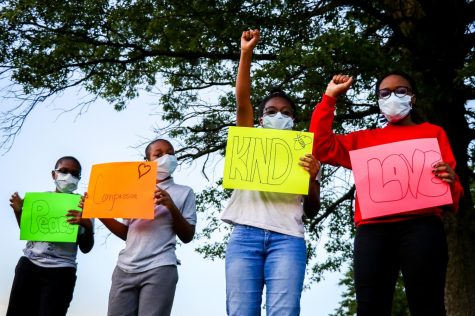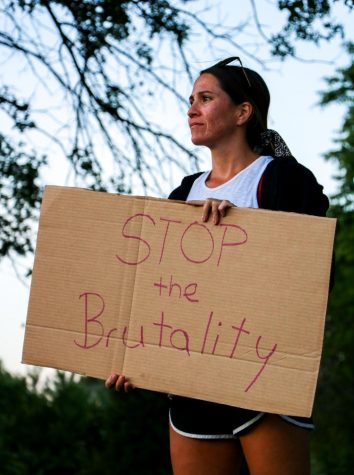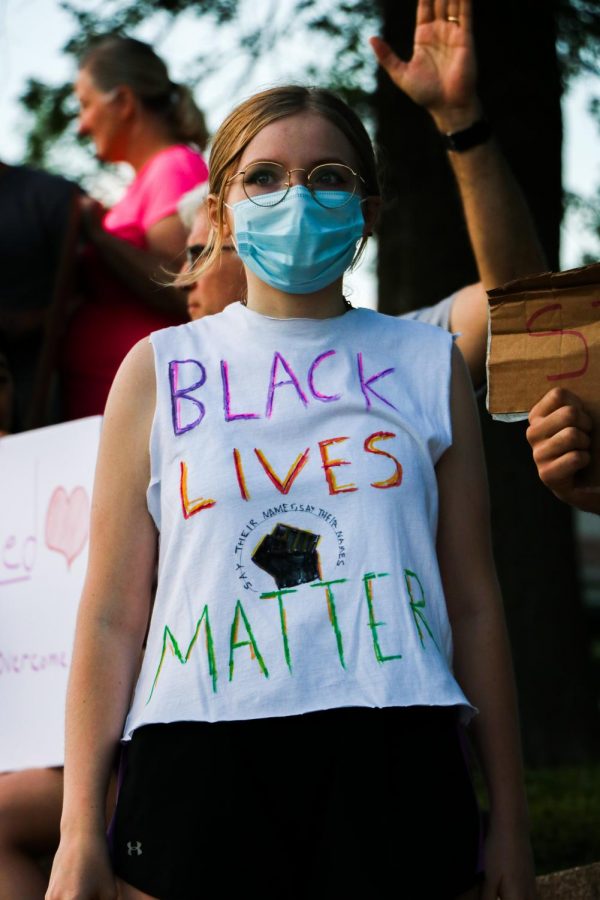BVNW students seek justice for George Floyd through protest
Three BVNW activists describe their experience with both peace and violence during the Black Lives Matter protests in the Kansas City area.
Rising senior Georgia Fite protests police brutality on Switzer Rd., May 31. “This is bringing voice to the struggle of the black community when oppression still lives on. It brings a voice to the need of reformation to our police force,” Fite said. (Photos by Rachel Sarff)
June 6, 2020
In light of the death of George Floyd on May 25 in Minneapolis, people in other cities across the world, including Kansas City, have protested against police brutality under the Black Lives Matter movement. Beginning May 29, activist groups including some BVNW students have protested around the Plaza and in Overland Park as an effort to spread awareness of racial injustice and discrimination in the U. S.
Rising senior Georgia Fite attended the protest near the J.C. Nichols Memorial Fountain on the Plaza Saturday evening, May 30, as well as the protest along Switzer Road on May 31. She said her decision to protest in-person along with social media was rooted in a desire for tangible support of the movement and the black community.
“I have gone to multiple protests for different topics because I believe in using my voice,” Fite said. “I cannot vote yet so I will speak and use my privilege to try and help the black community and make their voices heard. I have advocated on social media to educate, and I go to protests to show my ability to be an ally. I care about Black Lives Matter; I always have, and I always will.”
Fite said she had seen mixed reactions BVNW students have regarding the Black Lives Matter movement, but she is glad that these issues are being talked about.
“I have seen all sides, and I’m proud of people in our school realizing that there’s an issue,” Fite said. “But I have also seen racism and ignorance when someone told me ‘targeting African Americans isn’t such a bad idea.’ I am proud of students for speaking out, though, because change starts in your own community.”
A common way activists raise awareness is through social media, by spreading information about civil rights and participating in movements like #blackouttuesday on Instagram to recognize the challenges black citizens face. However, some students believe more action is necessary. Like Fite, 2020 graduate Lacy Mathes said she attended the protest on the Plaza to use her privilege as a voice for justice in the black community, and encourages others to do their part beyond social media.
“I don’t think it’s enough to just post. I wanted to use my privilege to do more,” Mathes said. “Even if people can’t go to protests, there are many other ways to help like donating, supporting black-owned businesses, signing petitions, and educating yourself and others.”
Rising junior Maggie Bunch, who also attended the Plaza protests, said she thinks BVNW has done a great job with promoting the movement, but fears some may treat it as a “trend” and not a legitimate problem.
“A majority of the people that I follow and I choose to surround myself with all have been really progressive with this whole matter and have taken to social media to express their views, but also to make sure to inform people where to donate, and where to educate themselves which I think is really, really good,” Bunch said. “But I also think there are some people that are treating this as a trend, and it shouldn’t be treated as a trend, it’s a movement and it should be respected as a movement. If you’re treating it as a trend, you’re part of the problem.”
Bunch, Mathes and Fite said they went to the protests with a goal to bring unity between cops and civilians while reforming the justice system for true equality.
Though the intentions of these protests were to peacefully raise awareness of racial injustice and unfair hardship for black people, the situation quickly escalated into riots for many cities. Reports of burning down buildings, looting stores and destroying property follow the protesters, creating a harder line dividing the police force and activists. To control the masses, police across the nation and in Kansas City resorted to tear gas and rubber bullets.
As of June 4, KCTV-5 said more than 200 people at the Plaza protest had been arrested; protesters destroyed many building windows lining the streets and set fire to a police cruiser. In an interview with KCTV-5,* David Jackson with the KCPD stated the police are at the protests to maintain peace and will stay there for as long as necessary.

Though she didn’t witness any looting or major violence on the protester’s side that would provoke the police, Mathes said she experienced the effects of tear gas as it hit her and those around her.
“I was really scared and I couldn’t see. I grabbed the shoulder of the person in front of me and we ducked and ran with the panicked protestors also trying to escape the gas,” Mathes said. “At first it didn’t hurt much, then my eyes became dry and the pain started. It didn’t just burn your eyes but also your skin and throat. It actually gave me a bloody nose after we left. Luckily people were there to help flush out your eyes. Mostly I was in disbelief of what happened; moments before we were kneeling and then we were fleeing.”
Due to the extensive media coverage of the riots and violence surrounding the Black Lives Matter protests, Bunch, who attended the Plaza protests, said her parents were nervous about the risks that came, but after a thorough discussion decided that it was safe enough at the time to attend.
“My dad was worried at first because he saw the riots in Minneapolis, but I kind of talked him through it because Kansas City wasn’t the center of where George Floyd died, so I don’t think the violence would have ensued. After Friday’s protest in Kansas City, it was peaceful; there was no one arrested with one window broken, and I was out really late at night. There was really nothing to worry about at that point so my dad was more than willing to let me go after a little bit of convincing. And then the rest of my family was totally fine and friends were really compliant.”
While she was at the protests, Bunch said an important aspect to the movement was beauty in the peace and solidarity among protesters, something the media sometimes overlooked.
“There was this really cool thing that happened where they were playing the music, it was a song. [A protester] was playing that and he was dancing, and there was everybody around him there waving their arms and clapping,” Bunch said. “It was the most beautiful thing ever because a lot of people choose to focus on the riots but they don’t see the amazing things that are happening at these peaceful protests of people coming together, wanting to understand each other and wanting justice for everybody to be treated equally.”

The Black Lives Matter movement began in 2013 after 17-year-old Trayvon Martin was shot and killed by “neighborhood watchman” George Zimmerman, who was found not guilty for the incident. On their website, this movement’s message is “imagining and creating a world free of anti-Blackness, where every Black person has the social, economic and political power to thrive.”
According to news reports, there have been 430 protest sites in all 50 states demanding reform of the police system and justice for the black people who have died at the hands of the police. Floyd’s death is believed to be racially driven and symbolic of the injustice in the police system, thus fueling some citizens to retaliate.
In a viral video posted shortly after his death, Floyd was arrested for allegedly passing a counterfeit $20 bill and eventually pinned under Police Officer Derek Chauvin’s knee for more than eight minutes, the probable cause of his death. He repeatedly told the policemen “I can’t breathe,” a phrase many protesters chant and display on signs. As of publication, all four officers face criminal charges, and Chauvin’s charge was upgraded to second-degree murder on June 3.
As the protests continue, Fite said she believes the best message to send to other protesters is one of encouragement, yet caution of the current events.
“Educate yourself on what is happening,” Fite said. “There is aggression, civil unrest, and movement. Do not be quiet. Silence is not an option.”
*BVNWnews reached out to KCPD Community Interaction Officer Andy Hamil in the central patrol division but he has not responded.



